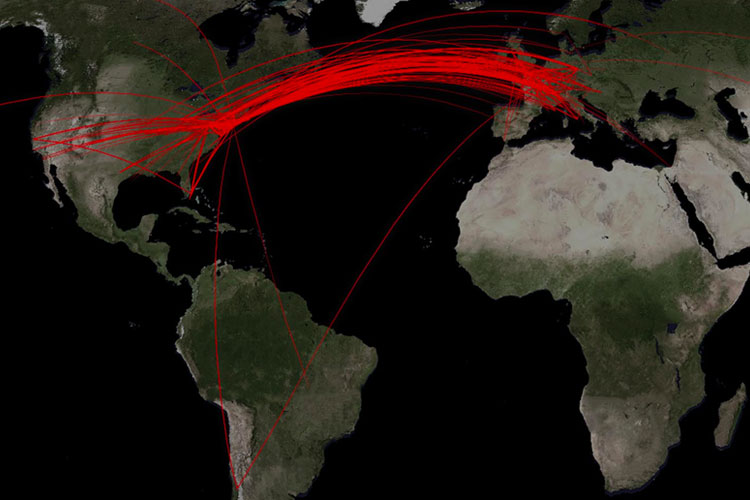The Northbrook Collection as Case Study
Surprising discoveries regularly emerge from the research into the provenances (ownership histories) of European paintings; most intriguing are the life stories of seven paintings which crossed paths once in the collection of the 19th-century Earls of Northbrook, and again in the galleries of Carnegie Museum of Art in Pittsburgh.
Provenance is a chronological record of ownership, custody, and location of an object. A complete provenance record provides historical context, helps in authentication of an object, and resolves issues of legal transfer.
The Northbrook Collection was selected for the CMOA digital provenance project due to the importance of the paintings in the collection, the complex history of its formation and dispersal over five generations, and its wealth of documentation.
- About the Northbrook Collection
- Research Methods and Data
- Relevance to the Field
- Articles and Publications
- Digital Provenance Symposia
- Software and Demonstration
About the Northbrook Collection
Beginning in the late 18th century, four generations of the Baring family of bankers formed one of the finest collections of English, French, Italian, and Dutch paintings in Britain, which follows the family’s social elevation to becoming the Earls of Northbrook.
The Northbrook Collection is also one of the best documented collections with sales and catalogues recording the family’s transactions:
- In 1814, the family sold their first Dutch painting collection to the Royal Collection Trust.
- In 1889, the family published an illustrated and descriptive catalogue of the collection.
- The family also sold some works through private sale and public auction. Today these works can be found in museums throughout the United States and Europe, including the seven examples in the collection of Carnegie Museum of Art.
In addition, the Baring Archive and the Northbrook family archives (Hampshire Record Office) are available for further research into their collecting.
Research Methods and Data
The museums’ underlying research is interdisciplinary. Curators and provenance researchers have combined traditional museum-oriented cataloging processes with archival and documentary research. The research methods also include the use of rapidly proliferating digital resources such as Union List of Artist Names Online, Hathi Trust Digital Library, the Internet Archive, and Google Books, among many others.
The provenance data collected for the Northbrook Project has been gathered from similar published sources along with communications with current owners, and additional original research. CMOA’s own Art Tracks Digital Provenance Project, which created a digital provenance standard, was also used to structure the provenance of collection objects and cross-reference them using Linked Data.
Together these research methods and data standards help create a more detailed and insightful object history than previously possible.
Relevance to the Field
As evidence, the companion exhibition, Created, Collected, Conserved: The Life Stories of Paintings, documents selected stories and moments that surround the formation and dispersal of the prestigious Northbrook Collection. These materials are supported by animated visualizations of the digital provenance data developed through these methodologies. Additional outcomes include; collection data, collection timeline, and bibliography.
The Northbrook Project demonstrates the value of a digital provenance standard and serves as a springboard for further study, innovation, and collaborations in digital humanities to develop new avenues for scholarly inquiry on the histories of art, collecting, and culture.
Articles and Publications
Several articles have been written about Art Tracks and the Northbrook related research.
- Pitz, Marylynne. “Chemist Reinvents Himself as Art Detective.” Pittsburgh Post Gazette (Pittsburgh, PA). December 1, 2017.
- Pitz, Marylynne. “Lady Anne, Shepherd Boy and Other Paintings Star in Carnegie Show.” Pittsburgh Post Gazette (Pittsburgh, PA). December 1, 2017.
- Ignatius, David. “How to Protect Against Fake ‘Facts’.” The Washington Post (Washington, D.C.). November 23, 2017.
- Berg-Fulton, Tracey, “Unraveling the Mystery of the ‘Laughing Boy’ Painting,” Storyboard (blog), April 5, 2016.
- Rouvalis, Cristina. “Divine Provenance.” Carnegie Magazine. Fall 2015.
Digital Provenance Symposia
As part of the Art Tracks Provenance Project and with the support of the National Endowment for the Humanities, CMOA hosted two digital provenance symposia:
Software and Demonstration
The Museum Provenance Library is the core technology developed for this project. It takes provenance records and converts them into structured, well-formatted data.
The Elysa tool is a user interface designed for museum professionals. It assists with verifying, cleaning, and modifying provenance records.
An initial provenance interactive prototype was created in spring 2015 to research ways to present detailed provenance information to the public. Much of the work and evaluation done has informed new projects, including the Northbrook data visualization in the Scaife galleries as part of the exhibition Created, Collected, Conserved.

